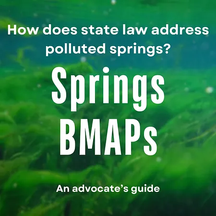
SPRINGS BMAPs
Basin Management Action Plans
BMAPs are the only tool the state has to reduce nitrates
and restore polluted, algae-choked springs to health.
If BMAPs don’t work, nothing else will.
That’s why we’re fighting to fix them.
Springs Are Polluted.
These plans were supposed to help.
Catch up quick:
-
Springs BMAPs were mandated by the Florida Legislature in 2016 to clean up polluted springs.
-
FDEP is responsible for creating these plans to reduce pollution in impaired springs.
-
FDEP released the first round of BMAPs in 2018, and it was clear they were flawed and doomed to fail.
-
Not surprisingly, since the plans have been in place, nitrate pollution has increased.
-
The Florida Springs Council sued over those plans, and a judge ruled FDEP had to do better.
-
Updated Springs BMAPs were released in 2025.
-
They’re still inadequate, and we continue to keep the pressure on.
Need a refresher? Click here to get a basic overview of what Springs BMAPs are.
A Statewide View:
3 Key takeaways from the most recent Springs BMAP
updates from FDEP

*
Agriculture remains the dominant source of pollution to Florida’s springs, followed by septic tanks.
Dairies, livestock, and farm fertilizer, all in shades of green here, account for 52.8% of nitrate pollution in springs statewide.
*OSTDS = onsite sewage treatment and disposal systems, or "septics"
1
2
The BMAPs put in place in 2018 should have reduced nitrate pollution. But nitrate levels in our springs have increased since they've been in place.
In 2018, DEP needed to reduce nitrates in impaired Outstanding Florida Springs by 68% within 20 years to meet water quality goals.
In the 2024 updates, because of increased pollution and wasted time, springs statewide must achieve a higher 72% reduction, and now the deadline is only 14 years away.


3
The vast majority of nitrogen entering Florida springs comes from three largely agricultural springsheds:
the Santa Fe,
the Suwannee,
the Silver/Rainbow.
Together they account for 76% of nitrogen entering our springs, and 81% of the required reductions statewide.
Without better plans to help agricultural producers reduce their impact, DEP is essentially giving up on these springs systems.
Spring by Spring
Now dig into the data for each of these impaired springs.
When DEP released its updates to Springs BMAPs in 2024, the Florida Springs Council dug into the updated data to answer three questions:
1. Where is the nitrogen pollution coming from for each springshed?
2. What is the difference in pollution levels in this springshed since the 2018 BMAPs were adopted?
3. How is it going? That is, has this BMAP been successful so far, and where has the 2018 BMAP put this springshed on its path to restoration?
A DEEPER DIVE
into Springs BMAPs
How does state law address polluted springs? Let's go back to the basics.
Here's the background you need on Springs BMAPs.
Florida's springs are suffering from nitrate pollution. The only tool the state has to reduce nitrates and restore springs to health are called Basin Management Action Plans, or BMAPs.
Click below to get an overview of what Springs BMAPs are and why they are so important to the future of our springs.
Watch an explainer video
to dig into the updated Springs BMAPs
On June 20, 2024, FSC hosted a live discussion to unpack the updates DEP had just provided for the new Springs BMAPs.
In this video we cover the history of the Springs BMAPs, the biggest polluters for each basin, the difference in pollution levels since the previous BMAPs were adopted, and how the Springs BMAPs have performed.
Watch the replay here, and see our overall takeaways about DEP's updates below, and keep scrolling for spring-by-spring information.




























